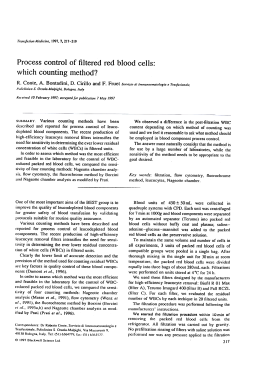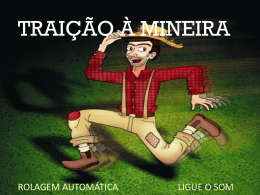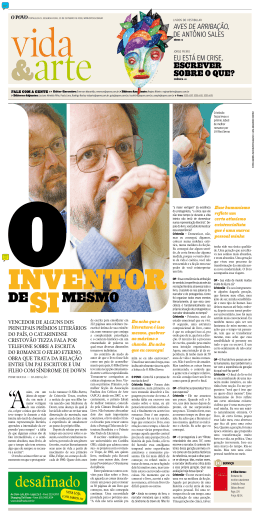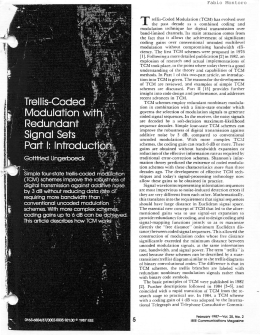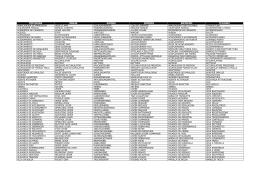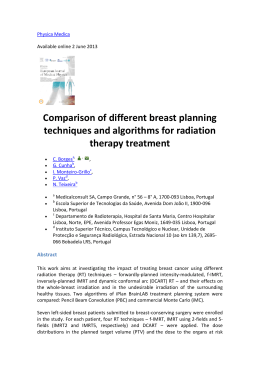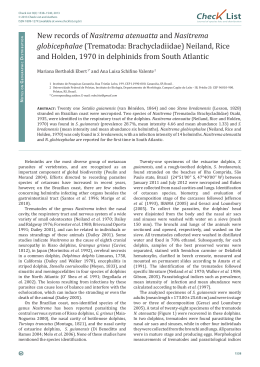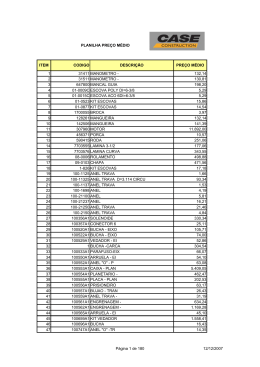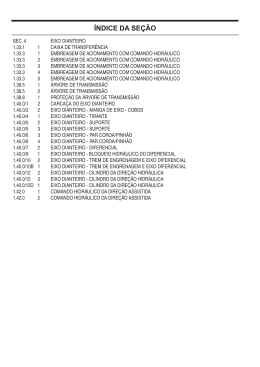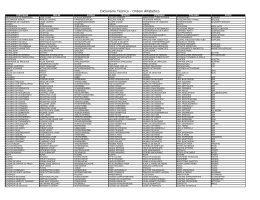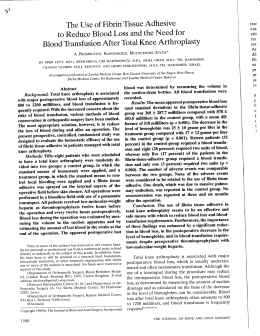Sep 15394 Virulence Variability of Puccinia coronata f. Sp. avenae Isolates Collected in Three Counties from Rio Grande do Sul State, Brazil E. A. Vieira, Ph.D., Embrapa Cerrados, c.P. 8223,733 J0-970, Planaltina, DF, BraziJ; F. L F. Carvalho, Ph.D., Universidade Federal de Pelotas, c.P. 354, 960JO-900, PeJotas, RS, Brazil; M. S. Chaves, Ph.D., Embrapa Trigo, c.P. 451,99001-970, Passo Fundo, RS, Brazil; A. Costa de Oliveira, Ph.D., Universidade Federal de Pelotas, 8raziJ; G. Benin, Ph.D., Universidade Tecnológica Federal do Paraná, Rodovia PR 469, km 01,85501-970, Pato Branco, PR, Brazil; and L Hartwig, M.Se., J. A. G. Silva, Ph.D., L Bertan, M.Se., A. F. Martins, B.Se., and L. F. Martins, M.Se., Universidade Federal de Pelotas, BraziJ ABSTRACT Vieira. E. A., Carvalho, F. r. F, Chaves, M. S., Costa ele Oliveira, A., Benin, G., Hartwig, 1., Silva. 1. A. G., Bertan, 1., Martins, A. F, anel Manins, L. F. 2007. Virulence variability 01' Puccil/ia comI/alo r. sp. avellae isolates coJlectcel in tlu'ee counLies from Rio Granele elo Sul State, Brazil. Plant Dis. 91 :66-70. Using isolates collecteel in three counties or Rio Granele cio Sul Slatc, Brazil, the goals or this work were to determine (i) the pallern of virulence 01' avirulence 01' the isolates to 25 Pc resistancc genes, (ii) the similarity in virulence among PlIccil/ia comI/ata r. sp. avel/ae isolates considering Iheir pallern of virulence or avirulence, (iii) lhe race coele for each isolale by the North American system 01' nomenclature, anel (iv) the supplemenlal Pc gcnes potentially useful as local e1illerenlials for P. comI/ara r. sp. avellae races. The results illdicale thal lhe southern Brazilian rusl isolates presenteei a high levei 01' virulence, because 66% 01' inoculations ll1allifestecl the high infection type. Only the Pc 68 gene was elTective against ali tesleel isolates. In general, each isolate presentecl a clifferent pattern or virulence 01' aviruléllce, which inelicates thc high variabilily for virulcncc that the fungus presents at the sampleel siles. Howcver, thc North Amcricall system or nomenclature was not c'olllpletely suflicient in e1istinguishing southern Brazilian raccs. Thus, the genes Pc 36, Pc 53, Pc 55, anel Pc 63 represent a possiblc gcne cOlllbination 10 be incorporaled inLo the North Amcrican systelll or nomenclature. [n lhe soulhern region 01' Brazil, hexaploid oat (Avena Saliva L.) is one 01' the mos I irnportanl winter cereais anel is used for grain produclion (food anel feeel purposes) in rolation with wheal, as weJl as a co]c1-season paslure (1,5). Brazilian oat brceeling programs slaneel releasing cultivars in lhe 1980s, breaking a Lraelition in which mosl 01' oat cultivars recommeneleel for commercial use in Bnlzil were bred in Urnguay and Argenlina. Ever since, oal breeeling in Brazil has achieveel excellenl rcsults for high yield, seeel size and weight, number 01' grains per panicle, plant slature, alulllinum tolerance, anel colei tolerance (1). Dcspite lhe progress altaineel for aelaplative characlers anel the industrial l]uality (ll1illing yielel) 01' white oat crops, few gains have been oblaineel rei ative to resistance to crown rusl (causeel by Puccinia COl'Ollo/a r. sp. ovel7ae) in Brazil, anel lhis is the most ill1porlant elisease a'ffecling oat proeluclion (21). The pathogen limits yielel Correspondillg author: E. A. Vieira E-mail: vic;[email protected] DOI: 10.10941 PD-91-0066 © 2007 The Al11erican Phytopalhological Society potenlial anel grain qualily in susceptible genolypes in Brazil (2,4,9, J 9,21), as well as \vorlelwide (11,13). Despire being lhe most efTicient type 01' eliseasc conlrol, vcrtical genelic resistance is consielerecl to have low elurabilily, such lhat genolypes rernain resislant for relalively short lime perioels (7, I 5). ln particular, lhe resistance eletennineel by one or a few genes can be overCOll1e by new pathogen races lhal arise by mutatíon 01' that migrate fronl other localions anel increase in frcqueney e1ue to strong selection pressure frolTl the cultivation 01' uniforl1lly resislanl genotypes over large areas (12). Stuelies perfonneel in Brazil have inelicateel the exislence 01' a great nUl1lber 01' e1islinet physiological raees 01' P coIDna/a f. sp. avel7ae as well as lhe presenee of complex races ("super raees") in soulhern Brazil. In 1997, Martinelli et aI. (20) eolleeted 53 fungal sal1lpJes in Rio Grande do Sul (RS), Sanla Catarina, anel Paraná States and ielenlitieel 53 c1islincl races, each carrying frorn 10 10 26 virulence genes, wilh an average of 20 genes per isolare. Cruz et aI. (iO) evalu:.llecl 28 oat e1ifferentia1 near-isugenic tines for P cOlono/([ (Pc) resislance genes in lhe lield anel ali expressecl the c1isease. Leonard anel I\!larlinelli (18) deterl1lineel the virulence paltern for 27 Pc genes 01' 144 soulhern-Brazilian fungal isolales (colleeteel between 1997 anel 1999), 36 Uruguayan isolates (colJecteel in 1994 and in 1998), anel 17 Russian isolales (collecteel in 1995). Wilhin lhe souLhern Brazilian and the Uruguayan isolales, Leonarel anel Martinelli (18) c1etennineel thm 70% were virulenl for 30 to 70% 01' lhe differentials, that there were a large nurnber of fungal races, anel thal there was no prevailing race. Moreover, Leonard and Maninelli (18) observeel that lhe complexity in vilUlence 01' southell1 Brazilian anel UlUguayan isolales was grealer than lhe COITlplexity in virulence of Russian isulales. Previous works have provieleel valuable insights regarding the variability and the cOl1lplexity or soulhern Brazilian P carona/a f. sp. avenae populations. However, il is essenlial to continuously survey P COIOna/a f. sp. avellae races occurring in th is region in order to unelerstanel lhe c1iversily, cOl1lplexily, anel evolutionary rale 01' pathogen populalions (arising frol11 new races). Through such surveys, il \Viii be possible lo elelermine prevailing races in major oat cuJtivation regions, aml to c1etect virulence phenotypes lhat pose a thrcal to currelltly gro\Vn oat cultivars. Surveys 01' viru1ence phenotypes in cereal rllsLs C1I1 proviele informalion on the elTcctivcncss 01' curremly usecl resistance genes and lhe pOlential effectiveness 01' genes lhaL havc not yet been widcly e1eployeel in cOllllllonly grown cllilivars anel to give Sllpport to local breeeling progl':.ll11S aiming to Illlprove cultivar resistance levels. Ba:ieel on the analysis 01' 46 pathogen isolales collecled in lhree cOllntics or Rio Grande do Sul Slate, Brazil, the goais 01' lhis work were to determine (i) lhe pattern 01' virulence 01' avirlllence 01' lhe isolales to 25 Pc resislance genes, (ii) the silllilarily [n virulence al110ng P corol/a/o f. sJl. avenCle isolales consielering their paltern 01' virulence or avirulence, (iii) the race code I'or cach isolale by the Norlh i\merican syslem 01' nomenclature for P corol/CI/a r. sp. (/\'eI/ae (Pca coele), anel (i v) supplelllcntal Pc gcnes potentíaJly useful as local e1i1lerentials for P corolla/a f. sp. avel/ae races. MATERIALS ANO lvlETHODS Leaf salllp1cs witil rust SYIl1Piull1S were collecteel from the Braziliall Recull1- mended Oat Cultivars Field Trial (EBJ:RA), fram 22 to 29 Scptember 2003 (soon afieI' plant flowering), in three locations (counlies) 01' RS Stale: (i) Passo Fundo (PF), located at 28°l5'46" latitude south and 52°24'24" longilude west at an altitude 01' 687 m; (ii) Capão do Leão (CL), located at 31°52'00" latitude soulh and 52°21'24" longitude west at an altitude 01' 13.24 m; and (iii) Eldorado do Sul (EL), situateel at 30°05'22" latitude south anel 51°39'08" longituele west at an altitude 01' 46 m. Leal' samples were air elried at raom temperature for aboul 48 h and then stored at 4°C at lhe Wheat Leal' and Stem Rusts Labaratory 01' Brazilian National Research Cenler for Wheal (EMBRAPA) at Passo Fundo, RS. Cv. UFRGS 7, which has exhibited high susceplibility lo crown rust in Brazil, was useel as a susceptible check (SC) for mulliplying field isolates. Seedlings 01' SC wilh a complelely exposed first leal' (7 days aI'ter sowing) were sprayed wilh Tween 20 solution (10 ll1 100 rnl-I); then, each seedling was inoculaleel with a single colJected fungal sample by scratching lhe spores using a slerilized spatula. After inoculation, each seedling was isolated in a plastic cone lo avoid crass conlamination between fungal isolales and placed in a dark chamber al 100% relative humielity and 20°C for l8 h. Seedlings were maintained in a greenhouse belween 20 anel 24"C and 60 to 80% relalive humidity. After 15 days in lhe greenhouse, a single pustuJe was selecleel on each inoculaleel planl and spores coUectcd from that single puslule were useel to inoculate anolher seedling, repcaling lhe proceelures 01' the original inoculations. After 15 elays, lhe praceelures were repeated for each monopustular isolale. The stralegy 01' lwo conseculive single-puslule isolations was roundeel by chlorosis or necrosis, 2 = small to ll1ediull1size uredia surrounded by chlorosis,3 = medium size ureelia in a chlorotic area, and 4 = large uredia without chlorosis or necrosis. Responses O, 1, and 2 were considered indicative of host resistance (1ow infection type) and responses 3 anel 4 were considered indicative of host susceplibility (high infection lype) (22). Each isolale showeel a parlicular combinalion 01' high and low infeclion types (virulence or avirulence) for the Pc genes 01' the elillerentials and receiveel a letter coele accoreling to the NASN for P co/v/wla f. sp. avenae (8). The NASN allows lhe aeldilion 01' new subgroups 01' four Pc genes and the aelelition 01' new letters lo lhe right 01' lhe currently used letters. Thus, lhe adelitional Pc genes used in lhese lests were eval uateel for their pOlential as local race eliffcrentials. The virulence or avirulence pallerns 01' isolates for each one 01' the stuelieel Pc genes were transformed to a binary scale where 1 = high infection typc or viru1ence and O = low infection type or avirulence. The similarity 01' virulence was eSlimaled for each pair 01' isolates, through an inelex 01' simple coincidence (ISC) accoreling to lhe equation ISC = C/N, where C is lhe number 01' differenlial lines on which a pair 01' isolates was either virulent or aviru1ent, and N is the tOlal nUlllber 01' differential !ines used (24). Based on lhe generaled similarity matI'ix, a c1endrogralll was constructed llsing lhe llllweighlecl pair group method wilh arilhmclic mcans (25). To verify lhe acljustment betweell lhe sil11ilarity l11alL-ixanel lhe oblaineel dendrogral11, a cophenelic corrclatioll coefficient (r) was calculated accordillg lo Sokal and Rolf (26), wilh lhe NTSYS pc 2.1 program (23). chosen lo guarantee the purity 01' obtaineel isolates anel, lherefore, increase the precision 01' race identificalion. AI'ter being submitteel to two consecutive single-pustule isolations, lhe spores 01' each 01' lhe 46 isolates were multiplied in five SC seedlings and 15 elays later were collecteel wilh the help 01' an air pump anel stored in a vacuum in glass lubes at 4"C. These spores Ialer were resuspendeel in water at a concenlration 01' 105 spores ml-I, lhen sprayeel onto seedlings 01' 25 Pc nearisogenic lines at the stage 01' completely exposed firsl leal' (7 elays afler sowing). Before inoculation, seeellings were sprayeel wilh a waler-Tween 20 solution (10 I1l 100 mt'). Afler inoculation, lhey were protecteel by a plastic cone (lo avoiel crosscontaminalion alllong isolates) anel placeel in a 100% humidily dark chamber for 18 h at 20°C for spore germination anel penetration. Afterwarel, seedlings were mainlained in greenhouse conelitions at belween 20 and 24"C and 60 lo 80% humielily. From lhe 25 Pc near-isogenic !ines evaluated, 16 were from the North American System 01' Nomenclature (NASN), proposeel by Chong et aI. (8) (Pc 40, Pc 45, Pc 46, Pc 50, Pc 38, Pc 39, Pc 48, Pc 68, Pc 51, Pc 52, Pc 58, Pc 59, Pc 54, Pc 56, Pc 62, and Pc 64) anel 9 were aelditional Pc isogenic lines (Pc /4, Pc 35, Pc 36, Pc 53, Pc 55, Pc 57, Pc 60, Pc 61, anel Pc 63). The crown rusl resistance genes evaluated were deriveJ from coJleclions 01' wild oat A. slerilis, cxcept for lhe Pc 14 gcne, which is fram Ascencao, a Brazilian cultivar 01' A. saliva (l8). Fifteen elays after inoculalion 01' the near-isogenic !ines, reactions were scored according to a scale from O to 4, where O = absent ureelia ar other ll1acroscopic infection symptoms, 1 = small uredia sur- 50 ",c:J - o .~ t:: c:J ::: :... 45 40 - 30 - 25 -•... 20 c:J r'" 35 .;: :.-- - , rI--- - - - - - - .:::J 15 t:: ::: Z 10 - '--- - 5 - - - .- O n, n Fig. 1. Number of lhe 46 isolales of Paccillia corolla/a f. sp. avellae originaled from Capão do Leão (CL), Passo Fundo (PF), and Eldorado do Sul (EL) counties, displaying virulence (high infection type) on each of the 25 Pc genes studied. RESULTS ~ From ali samples collecleel anel puritieel, 46 isolales af P coral/ala f. sp. OFenae were useel in lhis sluely, wilh 15 /i-om PF, 15 from EL, anel 16 from CL. Inoculalion of lhe 46 isolales on each of the 25 Pc near-isogenic lines resulleel in 1,150 infection sites, of which 764 (66%) showeel a virulence response (high infection type) anel 386 (34%) showeel an avirulence reaclion response (1ow infeclion type). Seven of lhe elirferentials (Pc 40, Pc 45, Pc 46, Pc 51, Pc 57, Pc 61. anel Pc 64) were susceptible lo more than 90% of the isolates testeel (Fig. 1). Only Pc 38, Pc 48, Pc 50, Pc 52, Pc 62, Pc 63, anel Pc 68 were resistant to more than 50% of the isolates in our tests (Fig. I). The gene Pc 68 was the most resistant elilTerential becallse none of OUl' isolales was virulent on it (Fig. 1). Baseei only on the Pc genes from the NASN for the funglls P coronata f. sp. avenae, il was possible to classify the 46 isolates in 30 elistincl races (Table 1). The mosl frequent race was SBP[-I, which occurreel six times (13%), but was not eletecteel in CL. The seconel most frequent race was SOTH, which occurreel four times (8.7%) but was not eletecleel in PE Another two races (SJTR anel SJRR) occurreel three limes (6.5%), whereas four races occllrreel two limes (4.3%; SSSR, SQNM, SDPIL anel SGPM). Twenty-two races were elelccted only once (Table 1). With lhe goal of quanlifying the efficiency of the NASN [or ielentifying raees of the fungus P coronala f. sp. avenae in southern Brazil, a cornparison was maele with the isolate virulence similarity, considering ali 25 genes lIseel in the present work. Only the isolales that presenteei the same virulenee and avirulence pattern for all 25 Pc genes revealeel an index of sim pIe eoincielence of 100% (i.e., were completely similar). Of the six isolales classitieel as race SBPH according to lhe NASN of fungus P coronata f. sp. avenae, tive had a similarity of 100% when the data from ali 25 Pc genes were used, indicating lhat sllch isolates probably represent the same race (Fig. 2). The onlyisolate lhat did not present J00% similarity was EL3, which has one extra virulence gene (Fig. 2). For the second most frequent raee, Table 1. Puccinia carona/a f. sp. avenae isolates collecled in Capão do Leão (CL), Passo Fundo (PF), and Eldorado do Sul (EL) Counties, nomenclature according to lhe onh American System (NASN) only, nomenclature including a new subset of Pc genes (Pc 36, Pc 53, Pc 55, and Pc 63) as local differentials, and number of virulence (vir) 01' avirulence (avr) genes for each isolate for lhe 25 Pc genes used Isolates NASN NASN plus Pc genes snbsel No. 01' virlavr gcncs EU EL8, PFI, PF6, PFII and PFI2 EL2 EL9. ELlO and CLl5 EL5, ELI3 ELII EU5 CU3 and CLl4 CU O and CUI CL5 and PF5 PFIO PFI4 CLl PF3 EL6 CL4 PF7 PFI5 EU ELl CL2 CLl6 ELl2 PF13 CLl2 CU EL4 PF2 CL9 CL8 PF4 PF9 PF8 ELl4 CU CL6 Average:l SBPH S8PH SDTI-l SDTI-l SJTR SJTR SJRR SJRR SSSR SQNM SDPJ-I SDPH SGPM SGPM QGTI SBNR S8PG SBPM S8PR SDMH SDPR SDTG SJSR SGFM SGLR SGNQ SGTR SLBM SLMR SQMM SQPR SQPT SSNM SSTM TGNM TQPT SBPI-lS SBPHQ SDTI-lS SDTI-IQ SJTRN SJTRS SJRRS SJRRN SSSRP SQNMP SDPHS SDPI-lG SGPMJ SGPMS QGTTS S8NRN SBPGQ SI3PMS SBPRQ SDMI-lS SDPRG SDTGQ SJSRN SGFMK SGLRN SGNQN SGTRN SLBMK SLMRF SQMMP SQPRP SQPTF SSNMP SSTMT TGNMS TQPTP 16/9 15110 1817 17/8 19/6 2015 19/6 1817 2015 16/9 1718 13112 16/9 16/9 19/6 15/10 14111 15/10 16/9 15/10 15/10 12113 1817 15110 14111 14/11 17/8 12113 16/9 1718 19/6 17/8 1817 2114 17/8 21/4 17/8 , Average of virulence/avirulence 68 genes. Plant Disease !Vol. 91 No. 1 SOTH, three isolates \Vere iclenlieal, bUl the fourth hael an exlra vi lU lence gene (Table I; Fig. 2). Races SJTR anel SJRR each had two ielenlical isolates anel one distinct isolate when ali 25 c1ilferentials were consielereel. Races SSSR and SQl M had two ielentieal isolates each, but races SDPH anel SGPM hael two eliSlincl i,olates each baseel on all 25 elifferentials. Cansidering lhe three collecting localions, there was no clear pattem of virulence variability distribution (Fig. 2), because the isolates eliel nol clusler accoreling Ia lhe collecling 10calion anel a high number of overJaps were eletecteel among lhe isolales from differenllocalions. The use of aLI25 Pc genes increased the number of isolates \Vilh elifferent virulence or avirulence pattems from 30 (NASN only) to 36 (Fig. 2). Among lhe samplecl isolates, those which presenleel lhe highest number of viruienee genes \Vere CL6 anel EL4, with 21 genes, whereas isolales lhal revealed the lowesl number of virulcnce genes were CLl6 anel PF2, Wilh J 2 virulence genes each. The mosl frequeJlI Jy collecled isolate, SBPH, was observeel to have 15 virulence genes anel lhe average number of virulence genes per isolale was 17 genes (Table 1). DISCUSSION The inoculation of the 46 soulhern Brazilian P coronala f. sp. avenae isolates on the 25 Pc near-isogenic lines resulleel in 66% virlllence response anel 34% avirulenee reaclion response, which inelicales generally high virulence of lhese isolales. Similar result was reporled by Leanarel et al. (17) with lsraeli P. coronala f. sp. GI'enae isolates. The differentials Pc 40, Pc 45, Pc 46, Pc 51, Pc 57, Pc 61, and Pc 64 were susceptible to more than 90% of the isolales tesled. Leonarel anel Martinelli (18) found that Pc 45, Pc 46, Pc 57, Pc 60, anel Pc 61 \Vere susceptible 10 more than 90% of lhe isolates that they collecteel in soulhern Brazil in 1997, but these elifferentials were susceptible to somewhat lower proportions (18 to 87%) of the isolates eollecteel in 1998 and 1999. Only Pc 38, Pc 48, Pc 50, Pc 52, Pc 62, Pc 63, anel Pc 68 were resistanl to more than 50% of lhe isolales in the present work, anel this is consislent with the low frequencies of virulence to these di[ferentials among the isolates Leonarel and Martinelli (18) evaluateel frum 1997 10 1999. None of OUl'isolates was virulent on Pc 68, showing lhat the Pc 68 gene was the most resistant differential, which also is similar to observations by Leonard anel Martinelli (18), who found (in 1997 to 1999) only 1 of 144 isolates from soulhern Brazil that was virulent on Pc 68. This gene is widely recognizeel as one of lhe most effective genes againsl this fungus (6,14). Despite lhe fact that lhe presenl work did not eleteet any Pc 68-virulent isolate, lhis resull is nol conc1usive evi~ence of lhe nonexislence of virulent isolales 10 this gene in soulhern Brazil, because the sluelieel isolates were collecleel in the EBCRA, where Bone of lhe cultivars presenllhis gene. In case one isolate woulel conlain lhe Pc 68 aviru!ence gene, this isolate woulel have a reeluceel fitness elue to an unnecessary gene for virulence, possibly resulting in a cOll1petitive elisaelvantage against olher non-Pc 68-containing isolates. Thus, an isolate containing this unnecessary gene will tenel to oecur in lower frequency. Because the number of isolates herein sluelieel was relatively small, it is possibJe thal, because of a sampling erro r, lhis particular Pc 68 isolale has not been collecteel. Nevertheless, Pc 68 is a potential source of resistance to the pathogen, but this only can be proven after its use in large areas for long perioels of time. Crown rust isolates collecleel on the California Islanels in the Uniteel States were not virulent to Pc 38, Pc 39, Pc 50, Pc 52, Pc 56, Pc 62, anel Pc 68 anel were not aviru1ent to Pc 14, Pc 45, Pc 46, anel Pc 54 (14). These resu1ts partially agree with the results herein elescribeel because, among lhe southern BraziJian isolates (i) viru1ence to Pc 68 was nol eleteeteel, (ii) the Pc genes Pc 38, Pc 50, anel Pc 62 were effective against a large number of iso1ates, (iii) the gene Pc 45 was not effective against any isolate, (iv) the Pc 46 gene was effective against only one isoJate, anel (v) the Pc 54 gene was effective against only 33% of lhe iso1ates. However, the results elisagree regarJing the genes Pc 39, Pc 52, anel Pc 56, which presenteei virulent isolates in the present work. Leonarel (16) a1so founel high frequencies of virulence to Pc 14, Pc 45, Pc 46, anel Pc 54 in isolates collecteel in California from 1990102000, anel a few isolates viru!ent to Pc 68 in the same perioel. Leonarel (16) inelicaleel that the virulence Ia Pc 45, Pc 46, anel Pc 54 oeeurreel at high frequency in southern Europe but not in northern Europe or in the Uniteel States, exeept for California. 1t is also interesting that van Niekerk et aI. (27) founel that virulence to Pc 45, Pc 46, anel Pc 54 occmreel at very high frequency in Soulh Africa, anel that LeonaI'eI anel Martinelli (18) eletecleel reJatively high frequencies of virulence to Pc 45, Pc 46, anel Pc 54 in Brazilian anel Uruguayan isolates. The reason for this apparent association of greater virulence in warmer c1imates is yet not c1ear. The use of ali 25 Pc genes (16 from NASN anel 9 others) increaseel the number of isolates with elifferent virulence or avirulence pattems from 30 (NASN only) to 36. Such results inelicate lhe presence of high variabilily in the population anel the neeel for inc1ueling new Pc genes in the NASN, for a better eliscrimjnation of Brazilian crown rust isolates. Therefore, we propose the inclusion of a new subgroup of four Pc genes (Pc 36, Pc 53, Pc 55, anel Pc 63, in that areler) to the NASN for the fungus P carona/a r. sp. avenae. The Pc 53, Pc 55, anel Pc 63 genes canelielales are 10 be aeleleel to lhe NASN as a new subgroup, because they presenteei a relative balance between the number of virulent anel avirulent isolates. The Pc 36 gene, which presenteei the lowest percentage of virulenl isolates among the remaineler genes, also is proposeel as parI of lhis aelelilion. Chong et aI. (8) chose not 10 inclllele lhe Pc 55 anel Pc 63 genes in lhe NASN elirferenlia!s, becallse these genes presenteei ielelllical reaclions to those of lhe Pc 39 anel Pc 38 genes, respeclively, when lesleel against Canaelian isolales of lhe fllngus. Nevertheless, in the presenl work, we suggesl lhe inc1l1sion of these genes in the nomenc1atme system, becallse lhese genes presenteei elifferent reactions loward the Brazilan isolates herein evalualeel, which also is in agreement wilh resu1ts reporteel by Martinelli et aI. (20), Cruz el aI. (lO), and Leonarel anel Martinelli (18). The inclusion of four aelditiona1 herein-proposeel genes in the NASN differenlial set was effective, because it elivieled lhe 46 isolales inlo 36 elistinct races, as well as the use or ali 25 Pc genes here eva1uateel. Both the NA5N anel our proposeel set of 20 differentials indicateel lhe presence of high virulence variability among lhe southern Brazilian isolates anel the nonexistence of a preelominant race. These results are in agreement with those of Martinelli el aI. (20), who detected 53 distinct races among 53 sOlllhern Brazilian isolales. NeverlheJess, lhe resulls reporlecl by 51J.\IIIU.1í SDTII,EI.:, SI)II~U.')) SDIHH 1111 SIri 111("1.1,') SDI'lkl'rWI SBPII(Fl31 SIlI'II(IL~' SIWI~I'r11 SIJI'I~pr(;) ~IU'I KI'I 11) SIU'II(PF I~) SIWR(E1I) SIWc.;(Pf71 q SI>f'RllL?i SIJI'II(l'rl·ll S(;I'\I, CLI) S(;P:O-HPF3, ·-·-----·I(iN~1(('L7) ·SBP:-.trl'FI5 .• S(;!·\I{I'FI.'] 5(;'IR(I'IAI Srlll(FU, SJTR(lU;, SI mlrUI; SISRIU lê) SJllR(lo1.l51 SIRRICl.IJI ~JRK'CI 1"1 <Xd 1"(101-''' S(;:-'QlCU, SIl'RICI.-1l S(iI.KICLl2) -----------~~r~.{lIJ.I_t1 ___________ .--1 SSSRICLlOI .----- SSSRICl.II) S<):'J \ 1{C1.51 S{,IN,\ljl'F"') SS\f\'11 JlI'S) "'"UPT('l (i) S()I'R(PF~) ~ l.'!1 s<,wnPllJ) SnrGItl.lú) ISLH\Url·':} SC;I~I\IiCL.'1 'SI \IRI( ~I-~-~-~-~-~l 0,:'10; __ ~_~_~_~_I_~_~_~ O.6l) I_~ 079 0.90 1.00 Fig. 2. Dendrogram of 46 PlIccillia carolla/a f. sp. avellae isolatcs, collected in three Rio Grande do Sul counlies, Passo Fundo (PF), Capão do Leão (CL). and Eldorado do Sul (EL), with their respective nomenclatures according to the North American Systelll for NOlllenclature (8). The dendrogram was obtained through the unweighted pair group Illethod with arithlllelic means clllstering method from the similarity index of simple coincidence, based on lhe pattems of virlllence and avirulence of the 46 isolates to lhe 25 Pc gencs cmployed in this stlldy. The value of lhc cophenetic correlation coefficient is 0.82. van Niekerk et a1. (27) show less diversity ln P coronata in South Africa than in Bra:il. Van Niekerk et aI. (27) evaluated isolates collected [rom eight locations over 2 years and founel only five races (SBLL, SGLL, PBBB, SDQL, anel JBBM) baseel on the NASN elifferentials. Among these races, only SBLL occurred at high frequency. We eliel not find any of the South African races in Brazil. The isolates CL6 anel EL4 presenteel the highest number of vimlence genes (21 gencs), whereas the isolates CLl6 anel PF2 presenleel the lowest (12 genes). SBPH was the mosl frequent isolate, presenting 15 virulence genes. With 17 genes as the average number of vimlence genes per isolate, resulls inelicate high pathogen race variabiJity anel a high number of super races. Thus, in Brazil, these two phenomena could explain the great elifficulties faceel by Brazilian oat breeelers when selecling for crown rusl resistance. The occurrence of super races in such high frequency occurs neither in the pathogen's center of origin in Israel (17) nor in the California Islanels, where the isolates present six virulence genes on average (14). Among lhe possible causes for such high variability in populations of the fungus causing crown rust, the most accepteel are (i) recombination of virulence genes via sexual crossings, (ii) asexual recombinalion via anastomosis (hyphal fusion), and (iii) mutalion stockpiling (7). In Brazil, there are no reports of a sexual cycle for lhis fungus, making asexual recombinalion or mutation stockpiling the major contlibutory factors of such high variability. Such evolutionary mechanisms probably are potentiaUzcel in Brazil elue to the fact that palhogens are broaelly spreael by winel (3), anel that the oat is cultivaleel year-rounel in the southernmost countries 01' South America. It is expected that asexual recombination anel mutations elo occur year rounel anel are wielespreael in this region. Anolher possible explanation is the fact that the isolates were collecteel in the EBCRA, where there is a high concentra, tion of elite genotypes presenting a large number 01' resistance genes. Such a coliection woulel generate strong selection pressure, leaeling to the establishment 01' a high number 01' vimlence genes. Apparenlly, there is no clear pattem 01' virulence variability elistribution among lhe three collecting locations herein anaIyzeel, because lhe isolates diel not clusler accoreling to the collecting location. There are lwo possible explanations for lhe absence of local cluslering tendency: (i) lhe ease of elispersal allows all isolates to be uniformly elistributeel throughout different locations 01' (ii) the isolates were collecteel on the EBCRA, which is representeel by the same cultivars in lhe lhree locations. The results of the present work corroborate lhe ielea lhat lhe southem Brazilian P coronata f. sp. avenae populations have a high variability for virulence. The inclusion 01' one subset of Pc genes in the NASN was sufficient to elistinguish the local isolates anel, lherefore, the permanent aelelition 01' this subset is recommeneleel to improve the efficiency 01' this system. Furlhermorc, we have shown that the isolates analyzeel in lhis sluely have a high leveI of virulence anel eliel not show a local grouping tenelency, inelicating that they are dislributed uniformly among the lhree locations of sampling. Moreover, the presenl stuelies demonstrale that some few genes still mainlain low virulence frequencies anel lhat the great diversity anel high levels of virulence among isolates of P coronata f. sp. avenae in Brazil will make it unlikely that long-lasting conlrol 01' crown rust can be obtained wilh race-specific resistance. ACKNOWLEDGIVlENTS We lhank FAPERGS, CNPq, and CAPES for lhe grants anel fcllowships receiveel; and lhe Brazilian National Research Center for Wheat (Embrapa Trigo) in Passo Funelo for facilities provided. LITERATURE lI. 12. 13. 14. 15. 16. 17. CrmD I. Barbosa-Neto, J. F., Matiello, R. R., Carvalho, F. l. F., Oliveira, J. M. S., Pego raro, D. G., Schneider. F, Sordi, M. E. B., and Vacaro, E. 2000. Progresso genético no melhoramento ria aveia-branca no sul rio Brasil. Pesqui. Agropecu. Bras. 35:1605-1612. 2. Benin, G., Carvalho, F. l. F., Oliveira, A. c., Lorencctli. c.. Vieira, E. A., Coimbra, J. L. M., Valério, l. P., Floss, E. 1... Berlan. 1., and Silva, G. O. 2005. Adaptabilidade e estabilidade em aveia em :l.l11bientes eSlratificados. Ciênc. RUf. 35:295-302. 3. Brown, J. K. M., anrl Hovmoller, M. S. 2002. Aerial elispersal aI' palhogens on the global anel continenlal scales anel ils impacl on plant elisease. Science 297:537-541. 4. Caeirãa, E., Carvalho, F J. F., Floss. E. L., Sánchez-Chacón, C. O., Lorecetti, c., and Marchioro. V. 2001. Efeito de níveis de severidaele e incielência da ferrugem-da-folha e ferrugem-elo-colmo no renelimento de linhagens ele aveia. Pesqui. Agropecu. Bras. 36:43-52 5. Carvalho, F F. 1., Barbosa-Neto, J. F., Floss, E., Ferreira, A. W. P. F, Franco, F A., Federizzi, L. c., and Nodari, R. O. 1987. Potencial genético da aveia, como produtora de grãos, no sul do Brasil. Pesqui. Agropecu. Bras. 22:7182. 6. Chong, J. 2000. Incirlence and virulence 01' PlIccinia coronata in Canaela from 1996 lo 1998. Cano J. Plant Palhol. 22:99-109. 7. Chong, J., and Kolmer, J. A. 1993. Distribution and virulence 01' PlIccinia carona/a f. sp. avelIae in Canaela in 1992. Cano J. Plant Palhol. 16:64-67. 8. Chong, J .. Leonard, K. J., and Salmeron, J. 1. 2000. A North Amcrican system 01' nomenclalure for PucciJlia coronaLa f. sp. Qvenae. Plant Dis. 84:580-585. 9. Cruz. R. P., Feelerizzi, L. c., and Milach, S. C. K. 1999. Severidade da ferrugem-da-folha e seus efeitos sobre caracteres da panícu1a de aveia. Pesqui. Agropecu. Bras. 34:543-551. 10. Cruz, R. P., Federizzi, L. c., anrl Milach, S. C. I<. 200 I. Genética da resistência à ferrugem- 18. 19. 20. 21. 22. 23. 24. 25. 26. 27. da-folha em aveia. Pesqui. Agropecu. Bras. 36:1127-1132. Doehlert, D. c., McMullen, M. S., and Hammonel, J. J. 2001. Genotypic and environmental effects on grain yielrl anel qualilY aI' oat grown in North Dakota. Crop Sci. 41:10661072. Harrler, D. E., anrl Haber. S. 1992. Oal e1iseases and pathologic techniques. Pages 307425 in: Oal Science and Technology. H. G. Marshall and M. E. Sorrells, eels. American Sociely 01' Agronomy Inc. "nrl Crap Science Society 01' America Inc., Madison, \VI. HoBand, I. B., and Munkvolcl, G. P. 200 I. Genetic relationships of crown rust resistance. grain yield, test weight, anel seed \veight in oaL Crop Sci. 41:1041-1050. Johnston. M. R., Carslen. L. D., Douglas, 1.., and Sands, D. C. 2000. Epidelllic deveJopment anel virulence in 1995-1998 01' PlIccillia coronata, a potential biocontrol agent 01' wild oats on San Clemente lsland. Biol. Control 17:250257. Kolmer, I. A., and Chong, J. 1993. Dislributian af virulence in two populations of Pucci/lia co!"onala f. sp. Qvel1ae in Canacla. Cano J. Bol. 71:946-950. Leonard, K. J. 2003. Regional frequencies 01' virulence in Dat crown rust in the United States from 1990 th.rough 2000. Planl Dis. 87: 13011310. Leonarel, K. I., Anikster, Y., anrl Manistersk.i, J. 2004. Patterns 01' virulence in natural popu1alions 01' PlIccillia corollata on wild oat in Israel and in agricultural papulations on cultivaterl oat in the Uniteel States. Phytopathology 94:505-514. Leonarel, K. I., and Martinelli. J. A. 2005. Virulence 01' oat crown rusl in Brasil and Uruguay. Plant Dis. 89:802-808. Lorencetti, c., Carvalho. F I. F, Marchioro, V. S., Benin, G., Oliveira, A. c., anel noss, E. L. 2004. Implicações da aplicação rle fungiciela nos parâmelros de adaptabilidaele e estabilidade de rendimento de grãos em aveia branca. Ciênc. RuI'. 34:693-700. MarlinelJi, I. A., Chaves, M. S .. Feelerizzi, L. c., Milach, S. C. 1<., anel Almeiela, J. L 1998. Análise da virulência de alguns isolados ele Puccillia carona/a avellae no Sul do Brasil. In: Reunião ela comissão brasileira de pesquisa de aveia. Instituto Agronômico do Parallá, Londrina,13razil. Martinelli, J. A., Federizzi, L. c., and Benneeleti, A. C. 1994. Redução do rendimento de grãos ele aveia em funçâo da severielaele ela ferrugem ela folha. Sumo Phytopalhol. 20: 116118. Murphy, H. C. 1935. Physiologic specialization in Pllcci,úa coral/ata avellae. U. S. Dep. Agric. Tech. BulI. 433. RohJf, F. J. 2000. NTSYS-pc: Numerical Taxonorny anrl Multivariate Allalysis System. Version 2.1. Exeter Software, Ne\V York. Sneath, P. H. A., and Sokal, R. R. 1973 Numeric Taxonomy: The Principies anrl Practice 01' Numerical Classification. W. H. Freeman, San Francisco. Sokal, R. R., anel Michener. C. D. 1958. A statistical melhoel for evalualing systematic relationships. Univ. Kansas Sci. BulI. 38: 14091438. Sobl, R. R., and Rohlf, F. J. 1962. The comparison of dendrograms by objeetive tnethods. Taxon 1I:30-40. van Niekerk, B. O .. Prelorins, Z. A .. and Boshoff, W. H. P. 2001. Pathogenic variability af Puccillia caronata r. sp. avenoe anel P. graminis f. sp. avellae 011 oal in South Africa. Planl Dis. 85: 1085-1090.
Download
